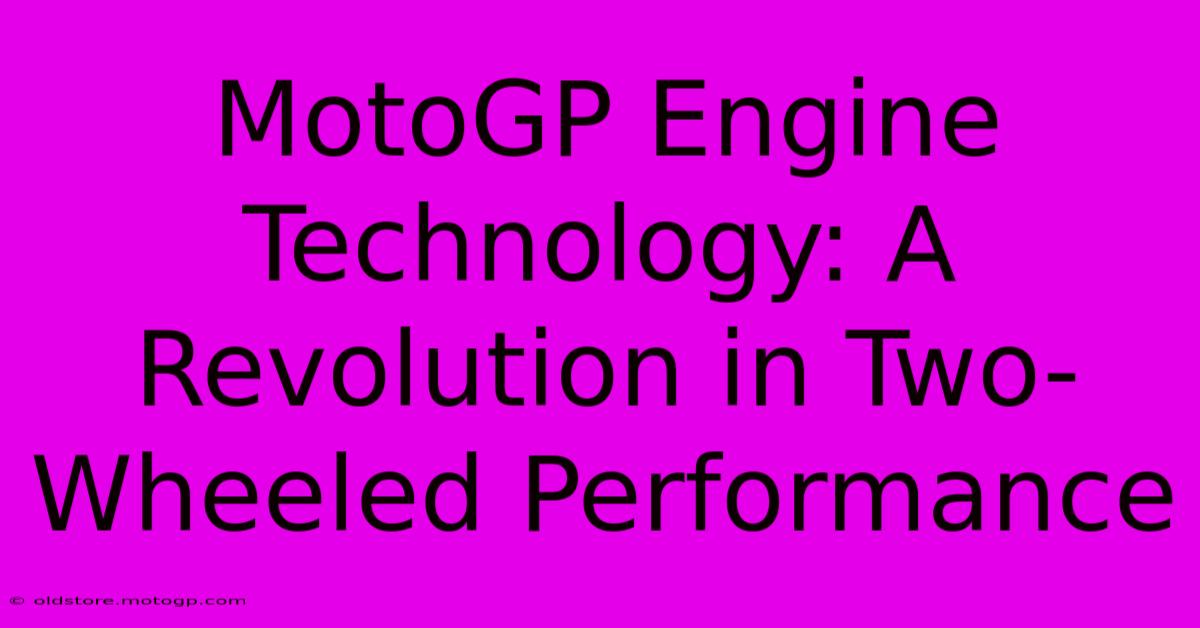MotoGP Engine Technology: A Revolution In Two-Wheeled Performance

Table of Contents
MotoGP Engine Technology: A Revolution in Two-Wheeled Performance
The roar of MotoGP engines is more than just captivating sound; it's a testament to cutting-edge engine technology pushing the boundaries of two-wheeled performance. This article delves into the heart of these magnificent machines, exploring the revolutionary advancements that define modern MotoGP racing.
The Reign of the Four-Stroke: Power and Refinement
Gone are the screaming two-stroke engines of yesteryear. Today, four-stroke engines dominate the MotoGP landscape, offering a potent blend of power, refinement, and environmental friendliness (relatively speaking, of course!). These engines, typically around 1000cc, are marvels of engineering, boasting incredible power-to-weight ratios and breathtaking horsepower figures.
Key Features of MotoGP Four-Stroke Engines:
- High-Performance Cylinder Heads: Sophisticated designs featuring multiple valves (often exceeding four per cylinder) and advanced valve actuation systems maximize airflow and combustion efficiency. Pneumatic valve systems are common, offering precise control and incredibly high RPM capabilities.
- Sophisticated Fuel Injection: Precise fuel delivery is paramount. Electronic fuel injection systems, coupled with advanced mapping and sensors, optimize fuel-air mixture for peak performance across the rev range.
- Lightweight Materials: Weight is the enemy of speed. Extensive use of titanium, carbon fiber, and other lightweight materials is crucial for reducing overall mass and enhancing handling.
- Advanced Engine Management Systems: These systems constantly monitor and adjust engine parameters, optimizing performance in real-time based on factors like throttle position, engine speed, and even track conditions. Sophisticated data logging allows teams to fine-tune engine settings with incredible precision.
- Seamless Shift Transmissions: Quick shifts are essential for maintaining momentum. Seamless shift transmissions allow for gear changes without interrupting power delivery, contributing to faster lap times.
Beyond Horsepower: The Pursuit of Efficiency and Reliability
While sheer power is vital, MotoGP engine development is equally focused on efficiency and reliability. These machines endure extreme stress, pushing components to their limits lap after lap.
Key Considerations in Engine Development:
- Aerodynamics: While not directly part of the engine, aerodynamics play a crucial role in overall performance. MotoGP bikes feature highly sophisticated aerodynamic packages, including winglets and fairings, which reduce drag and improve stability at high speeds.
- Engine Mapping and Calibration: Engine mapping is constantly refined to optimize power delivery across the entire rev range, balancing peak power with driveability and control.
- Thermal Management: High temperatures are a significant challenge. Effective cooling systems are critical for preventing engine damage and maintaining optimal performance.
- Material Science Advancements: The constant quest for lighter, stronger, and more durable materials drives innovation in engine construction. Advanced materials and manufacturing techniques are pushing the limits of what's possible.
The Future of MotoGP Engine Technology
The evolution of MotoGP engine technology continues at a rapid pace. Future developments may include:
- Hybrid Systems: The integration of hybrid technology could offer further performance gains, particularly in areas such as acceleration and braking.
- Advanced Combustion Strategies: Innovations like variable valve timing and cylinder deactivation could further improve efficiency and reduce emissions.
- Artificial Intelligence (AI): AI-powered engine management systems could offer even greater optimization and predictive capabilities.
The MotoGP engine is a testament to human ingenuity. Its relentless evolution pushes the boundaries of performance, engineering, and technological innovation, providing a thrilling spectacle for fans worldwide. The competition is fierce, and the pursuit of the perfect engine continues to drive innovation in this exciting motorsport.

Thank you for visiting our website wich cover about MotoGP Engine Technology: A Revolution In Two-Wheeled Performance. We hope the information provided has been useful to you. Feel free to contact us if you have any questions or need further assistance. See you next time and dont miss to bookmark.
Featured Posts
-
F1 Austin Parking Simple And Convenient
Feb 19, 2025
-
Cota Austin Schedule Your Key To A Stress Free Race Weekend
Feb 19, 2025
-
Dont Miss The Action Cotas Event Highlights
Feb 19, 2025
-
Moto Gp Replay Your Window Into The World Of Champions
Feb 19, 2025
-
Moto Gp Replay Experience The Evolution Of Moto Gp
Feb 19, 2025
